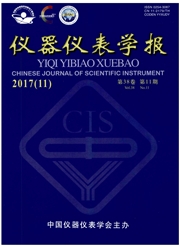

 中文摘要:
中文摘要:
为改善L1范数广义逆波束形成性能,提出了一种光滑L0范数广义逆波束形成算法。该算法充分利用L0范数能充分反映单极子噪声源信号稀疏本质的特性,结合光滑L0范数方法通过少数几次迭代即得到噪声源信号的稀疏解。首先,基于数值模拟的声源识别成像图以及声学半径曲线探究其结果随声源频率、阵列形式的变化规律,结果表明光滑L0范数广义逆波束形成相比L1广义逆波束形成,在相同的空间分辨率情况下,需要的传感器测量值更少;在相同的声阵列形式下,光滑L0范数广义逆波束形成的空间分辨率更高。最后,通过实验算例对单极子声源进行了声学成像,结果表明光滑L0范数广义逆波束形成相比其他波束形成,能更好地识别噪声源,进一步验证了该算法的有效性及实用性。
 英文摘要:
英文摘要:
To improve the performance of L1 norm generalized inverse beamforming, a new noise source detection algorithm was developed based on SL0-GIB ( smoothed L0 norm generalized inverse beamforming). This method adequately utilizes the characteristic that L0 norm can fully reflect the sparsity nature of monopole noise source signal; and can obtain the sparsity solution of the noise source with a few times of iterations by combining smoothed L0 norm method. Firstly, the varying rules of the sound source identification resuhs with signal frequency and array type are explored based on numerical simulated sound source identification imaging maps and standard deviation curves of the acoustic radius. The smoothed L0 norm GIB is compared with L1 - GIB ( L1 norm generalized inverse beamforming). The results indicate that under the same spatial resolution the smoothed L0 norm generalized inverse beamforming requires fewer pressure hydrophone measurement values ; and under the same acoustic array type, the SL0-GIB has higher spatial resolution. Finally, as a test example, the acoustic imaging of monopole noise source was conducted. Experiment and data analysis results show that the smoothed L0 norm generalized inverse beamforming can identify the noise source position better, and the resolution of the proposed algorithm is substantially higher than that of other algorithms, which further verifies the effectiveness and practicality of the proposed algorithm.
 同期刊论文项目
同期刊论文项目
 同项目期刊论文
同项目期刊论文
 期刊信息
期刊信息
